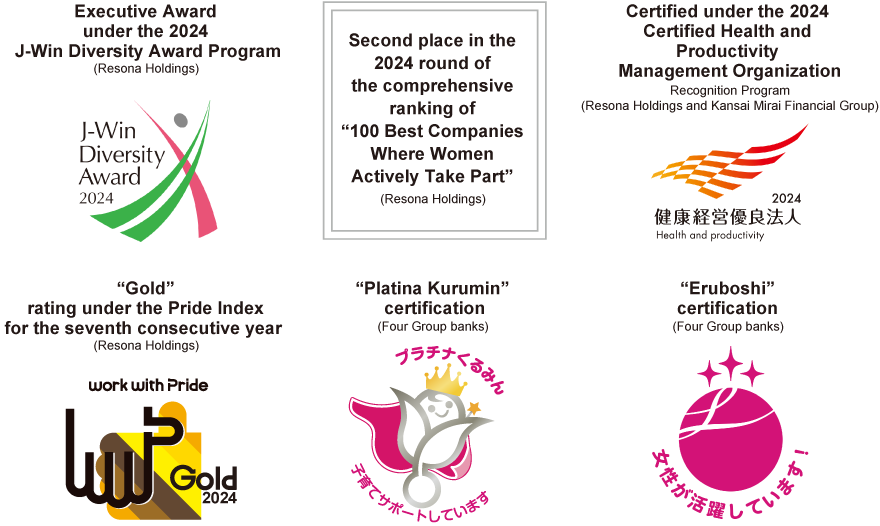Long-Term Sustainability Indicators
To realize its Purpose of "Beyond Finance, For a Brighter Future," the Resona Group aims to create a sustainable, virtuous cycle offering new value creation to adapt to the changing times together with our customers and well-being to our employees who are the driving force behind this. In May 2023, we published our Long-Term Sustainability Indicators, which systematically organize the value we should provide into value for customers and society as well as value for employees. We aim to be a corporate group that contributes to improving various values for multiple stakeholders by solving our customers' challenges and social issues.
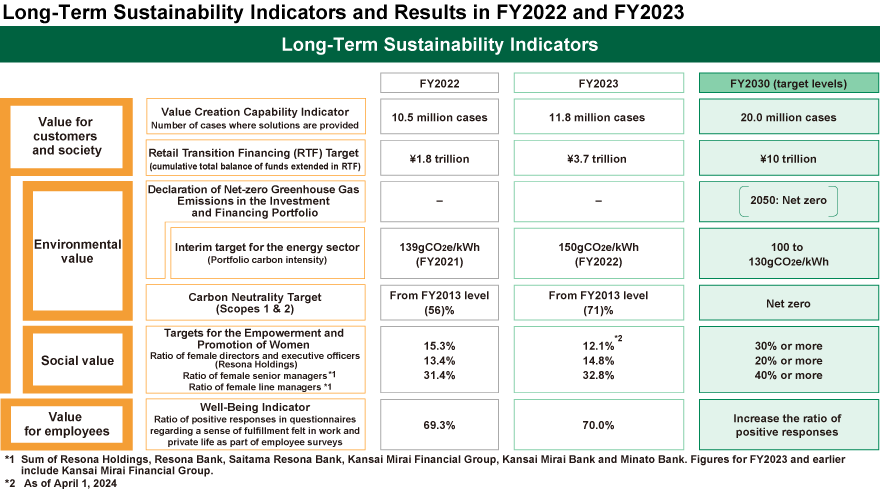
About the each Indicators
| Value Creation Capability Indicator | Indicator that quantitatively represents the extent to which various solutions are being created and provided to the increasingly diverse and sophisticated problems faced by customers and social issues (established in May 2023) |
|---|---|
| Retail Transition Financing (RTF) Target | Financing transaction volume target that will contribute to the transition in awareness and behavior of retail customers regarding the promotion of SX (including financing in the environment-related fields) (established in June 2021) |
| Carbon Neutrality Target (Scopes 1 & 2) |
Target to reduce CO2 emissions (Scope 1 and 2) attributable to energy used by the Group to net zero by the end of FY2030 (established in June 2021) |
| Declaration of Net-zero Greenhouse Gas Emissions in the Investment and Financing Interim target for the energy sector |
Declaration of our intention to reduce greenhouse gas (GHG) emissions from our investment and financing portfolio to net zero by 2050 and carbon intensity target for the power sector for FY2030 set as a milestone towards achieving this intention (established in May 2023) |
| Targets for the Empowerment and Promotion of Women |
Target ratio of women in executive, senior management, and line management positions that was set to expand opportunities for women’s empowerment and promotion, aiming to create new value through diversity (established in June 2021) |
| Well-Being Indicator |
Indicator that represents the percentage of positive responses to the employee survey on work-life satisfaction aimed at a sense of fulfillment in both work and private lives for our Group employees (established in May 2023) |
Please see below for detailed performance and progress of key indicators.
- Retail Transition Financing Target
- Declaration of Net-zero Greenhouse Gas Emissions in the Investment and Financing Portfolio
- Interim target for the energy sector
- Carbon Neutrality Target(Scope1、 Scope2)
- Targets for the Empowerment and Promotion of Women
Retail Transition Financing Target
- Cumulative total of transition financing from FY2021 to FY2030: 10 trillion yen
-
Financing Coverage
Financing aimed at helping retail customers update their awareness, transform their modes of behavior and stably move forward from their current situation. (Including financing for such green projects as renewable energy generation, as well as large corporate financing involving third-party verification)
FY2023 results: Approximately 1.9 trillion yen (Cumulative total since FY2021: 3.7 trillion yen)*3
| Breakdown of Financing |
Investment and financing aimed at supporting or facilitating initiatives to promote social or business sustainability Investment and financing requiring recipients to use such funds for the resolution of social issues (Main examples)
|
|---|---|
| Financing in the environment- related fields |
Investment and financing aimed at supporting or facilitating initiatives to address environmental issues (Main examples)
|
- *3Performance of each bank in the Group: Resona Bank approx. 1.44 trillion yen, Saitama Resona Bank approx. 240 billion yen, Kansai Mirai Bank approx. 130 billion yen, Minato Bank approx. 60 billion yen (of which, financing in the environment-related fields: Resona Bank approx. 380 billion yen, Saitama Resona Bank approx. 70 billion yen, Kansai Mirai Bank approx. 30 billion yen, Minato Bank approx. 10 billion yen) Investment trusts and investment advisory services run by Resona Asset Management.
- *4Investment trusts and investment advisory services run by Resona Asset Management.
Review of FY2023 Accomplishments and Future Initiatives
In FY2023, the balance of funds extended in retail transition financing grew around 1.9 times from the previous fiscal year to 1.9 trillion yen, bringing the cumulative three-year total to roughly 3.7 trillion yen. This represented a progress ratio of 37% against to our target of 10 trillion yen. The above growth in the financing balance was mainly attributable to Sustainability-Linked Loans (SLLs) for large corporations and social loans for public sector customers, as well as the robust performance of SX financing for SMEs and housing loan products designed to help address environmental and social concerns.
Looking at the breakdown, financing in the environment-related field increased around 1.7 times year on year to approximately 510 billion yen. Of this, funds extended as financing in conformity with external sustainability standards, such as the Green Loan Principles, accounted for more than 90%. Moreover, the volume of funds extended in other fields increased roughly twofold to approximately 1.4 trillion yen, with nearly half this amount extended in financing in conformity with such external standards as Social Loan Principles.
With regard to the provision of non-financing solutions, our simplified CO2 emission calculation service released in the previous fiscal year to help SMEs visualize the volume of their CO2 emissions was used on around 4,000 occasions, an increase of roughly 1.5 times year on year. We also focused on providing SDG-related matching services*5 to support interaction and cooperation among customers in connection with the United Nations Sustainable Development Goals (SDGs). In FY2023, these services led to roughly 1,600 cases of successful matching.
As such, our financing and non-financing solutions are even more sought after than they were a year earlier. However, we are still only halfway through the journey toward realizing our vision, which states, “In striving to update the Group’s business model, we help customers embrace new lifestyle norms so that we can together adapt to change” and “We aim to become the most significant contributor to customer success in SX.” We will continue to facilitate in-depth dialogue with customers while strengthening our ability to deliver solutions.
- *5Matching services involving referrals to SDGs-related products and services handled and relevant seminars hosted by other corporate customers, etc.

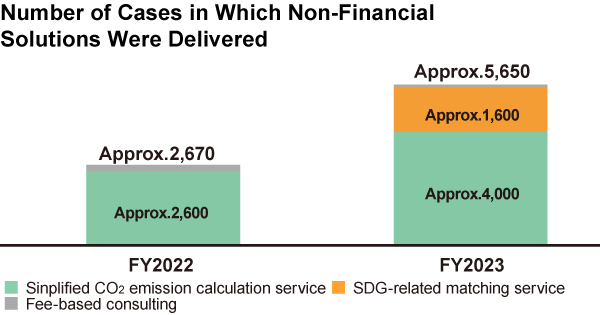
Steps of Our Response Aimed at Helping Customers Update Their Awareness and Transform Their Modes of Behavior
The Resona Group has taken the various types of organizational action it is able to take to help customers update their awareness and transform their modes of behavior and arranged them as six steps as illustrated in the diagram on the right.
Every year, we specify a step for particular focus. For FY2023, the Group focused on two steps “gathering information” (step 4), i.e., helping customers systematically assess their current situation via the use of a broader perspective, and “providing SX-related solutions” (step 5), rallying its entire strength to serve corporate customers.
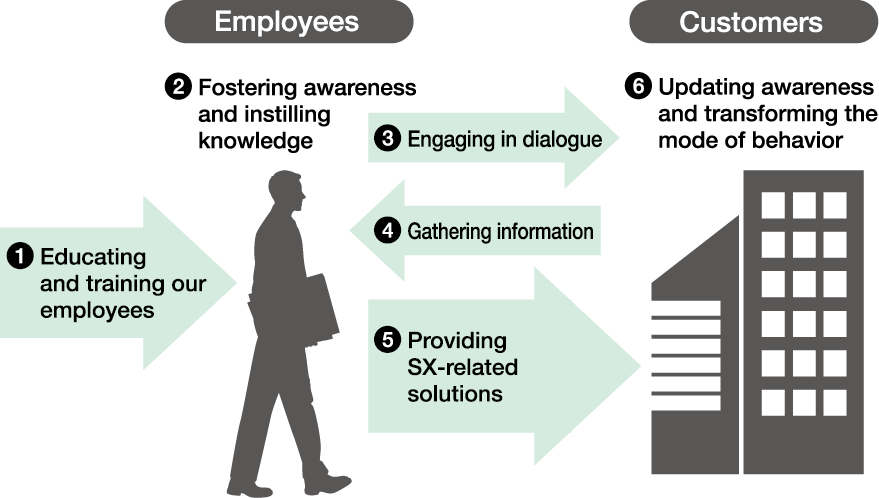
Formulating a Flow of Carbon Neutrality Initiatives in Accordance with the Group’s Standards
Drawing on knowledge accumulated through dealing with a wide variety of cases over the course of the initiatives described above, we have formulated a flow of model initiatives for SMEs using standards we have formulated—to help them properly respond to urgent public calls for carbon neutrality and steadily move forward from their current situation. In FY2024, we will utilize this flow to help customers assess their current situation and identify the steps they should take next. In this way, we will engage in in-depth dialogue with customers and deliver optimal solutions aligned with varied situations they face.

Delivering SX-Related Solutions Appropriate to the Stages of Customer Initiatives
The status of sustainability efforts undertaken by SMEs and the management resources they can afford to allocate to such efforts vary greatly by company. Accordingly, we deliver and continually work to upgrade our diverse solution lineup to best assist each SME seeking to push ahead with sustainability initiatives appropriate to their current situation.
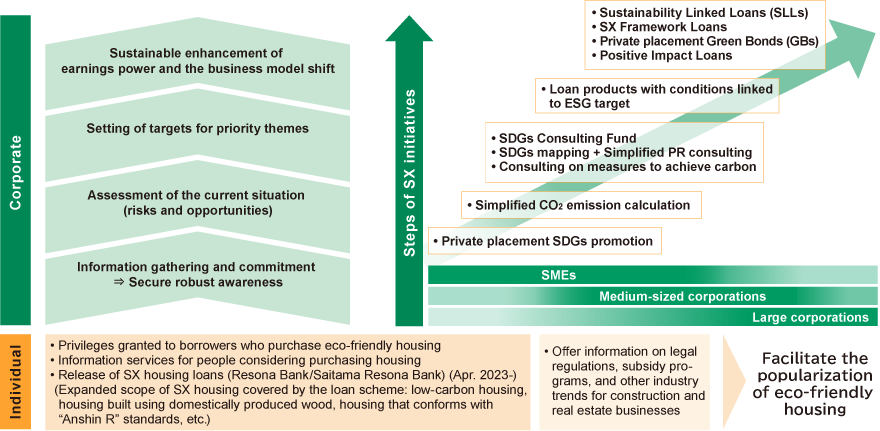
Declaration of Net-zero Greenhouse Gas Emissions in the Investment and Financing Portfolio
- Aiming for Net-zero Emissions in Terms of GHG Emissions from the Investment and Financing Portfolio by 2050
Calculation of GHG Emissions from the Investment and Financing Portfolio
Financed Emissions represent indirect GHG emissions associated with investment and financing undertaken by financial institutions and account for the largest proportion of emissions attributable to such institutions’ activities.
In order to promote the measurement, monitoring and reduction of financed emissions, the Group calculates portfolio related GHG emissions volumes in accordance with standards formulated by the PCAF*6, an international initiative, prioritizing carbon-related sectors specified by the TCFD. As the above calculation is performed using a simplified method based mostly on estimated values provided by the PCAF database, the Group recognizes the possibility of deviation from the actual volume of GHG emissions.
In addition, loans to SME customers account for the majority of the Group’s loan balance. Looking ahead, we will promote in-depth dialogue with customers and step up our supportive efforts to act as their “running partner,” with the aim of facilitating the widespread practice of emissions-related disclosure among business corporations while helping them adopt more sophisticated methods for the calculation of emissions volumes.
- *6Partnership for Carbon Accounting Financials
Financed Emissions Calculated Based on the PCAF Standards
| Sector | Credit amounts (billions of yen) |
Portfolio-related GHG emissions volume (Mt-CO2e) 〈Scope1+2〉 |
Portfolio-related GHG emissions volume (Mt-CO2e) 〈Scope3〉 |
Measurement coverage ratio (%) |
|---|---|---|---|---|
| Energy / Utility | 543.7 | 5.0 | 19.8 | 90.2 |
| Transportation / Automotive | 1,366.1 | 4.6 | 29.3 | 99.6 |
| Real estate development / Construction | 6,919.6 | 1.4 | 24.7 | 98.7 |
| Material | 592.8 | 6.6 | 20.8 | 98.4 |
| Agriculture / Food | 342.2 | 1.2 | 3.7 | 99.2 |
| Pulp / Forestry products | 130.9 | 0.5 | 1.3 | 99.2 |
| Total | 9,895.3 | 19.6 | 99.8 | 98.4 |
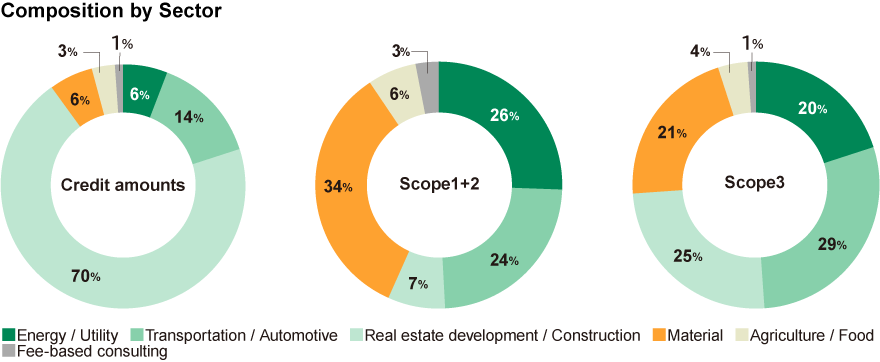
Results of the PCAF-Based Calculation of Financed Emissions
| Target assets |
|
|---|---|
| Target sectors |
|
| Target years |
|
| Formula |
|
Interim Target for the Energy Sector
- Carbon emission intensity in FY2030: 100 to 130gCO2e/kWh
Financed Emissions Associated with the Energy Sector (as of March 31, 2023)
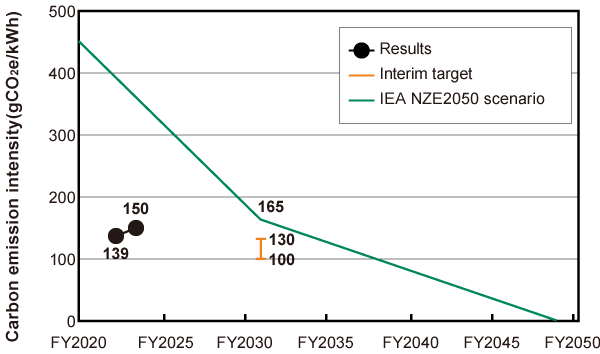
As of March 31, 2023, the carbon emission intensity of the energy sector amounted to 150gCO2e/kWh, an increase of 11gCO2e/kWh year on year, yet remained below the level*7 specified under the 1.5 °C scenario (NZE2050) for 2030.
The factors leading to this increase included growth in the volume of energy sourced from thermal power plants due to the prolongation of periodic inspections targeting nuclear power plants run by some clients. On the other hand, the proportion of funds extended in financing for renewable energy power generation in the overall balance of investment in and financing for the energy sector remained virtually unchanged thanks to our proactive financing efforts in this field (50% as of March 31, 2022; 51% as of March 31, 2023).
- *7Comparison with the estimated carbon emission intensity of 165gCO2e/kWh for 2030 under the NZE2050 (WEO2022).
| Scope subject to GHG emission calculation | Indicator | Results (Mar. 31, 2023) |
Amount of investment and financing | Coverage ratio | Data quality score | |
|---|---|---|---|---|---|---|
| Energy (electric power) |
Power generation Scope 1 |
Physical carbon emission intensity | 150 gCO2e/kWh |
315.4 billion yen | 89% | 2.1 |
| Oil / Gas | Mining Scopes 1 to 3 | Absolute volume | 0.17 MtCO2e |
6.0 billion yen | 100% | 2.8 |
| Coal | Mining Scopes 1 to 3 | Absolute volume | - | (Not applicable) | - | - |
Classification of Investees in Terms of Progress toward Setting Decarbonization Targets
The amount of funds we have extended to clients who specialize in emission-free renewable energy power generation accounts for around a half of the funds extended in investment and financing for clients engaged in power generation. In addition, a majority of other clients have already set interim targets that satisfy Japan’s Nationally Determined Contribution (NDC) standards.
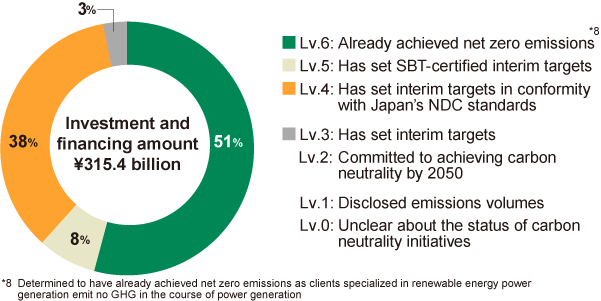
Support Policies for the Energy Sector
The energy sector is an infrastructure component supporting all industries as well as people’s daily lives. Accordingly, pursuing the decarbonization of this sector is essential to facilitating decarbonization among our retail customers. As the characteristics of power generation businesses differgreatly by region, decarbonization efforts must give due consideration to country and region-specific factors. Looking at factors specific to Japan, the country’s energy base is highly dependent on coal- and gas-fired thermal power generation. Moreover, there is a lack of land suited for establishing transmission networks and renewable energy power plants.
The majority of the Group’s portfolio of financing for the energy sector is accounted for by financing for domestic businesses and projects. Therefore, we will give due consideration to domestic circumstances to support the stable supply of energy even as we contribute to the widespread use of renewable energy an essential solution for decarbonization while helping clients achieve transition and technological innovation. In these ways, we will continue playing our part in the decarbonization of Japan’s energy sector.
Our Stance on Lending to Coal-Fired Thermal Power Generators
The Group has established and announced its “Basic Stance on Lending,” which includes a policy of abstaining from freshly extending financing for coal-fired thermal power generation, except when it finds compelling reasons to do so, such as to realize economic restoration following a disaster. The Group also plans to reduce the balance of credits extended in connection with financing for existing coal-fired power generation projects to zero by the end of FY2035.
Carbon Neutrality Target(Scope1、 Scope2)
- Reduce CO2 emissions*9 attributable to energy used by the Resona Group to net zero by the end of FY2030
- *9Sum of Scope 1 and Scope 2
FY2023 results: 71% reduction from the FY2013 level (a year-on-year decrease of 14,192 t-CO2)
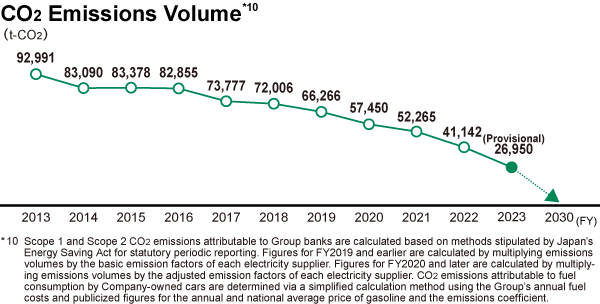
Breakdown of FY2023 Emissions (Provisional)
| Scope1 | 4,898 |
|---|---|
| Scope2 | 22,052 |
Emissions from energy sources |
21,188 |
| 合計 | 26,950 |
Since approximately 80% of CO2 emissions from Group operations are attributable to energy use, we initiated a phased switchover to energy procured from renewable energy sources in FY2021, starting with energy-intensive facilities.
By the end of FY2022, we completed this switchover at Head Office, back-office centers and other energy-intensive facilities. In FY2023, we began ramping up to a similar, full-scale switchover at branches. As a result, the volume of CO2 emissions attributable to the Resona Group’s operations in FY2023 were down 71% (provisional basis) compared with the FY2013 level. This also represented a year-on-year decrease of 14,192 t-CO2.
In FY2023, we became a member of the “GX League” promoted by the Ministry of Economy, Trade and Industry, and formulated interim emission reduction targets for FY2025.
Going forward, we will continue to promote energy-saving activities across the board to curb the financial impact of the current surge in energy prices and offset costs associated with the switchover to renewable energy to ensure that we can lead the way in the energy transition of our own operations.
CO2 reduction effect by introducing renewable energy, etc.*11
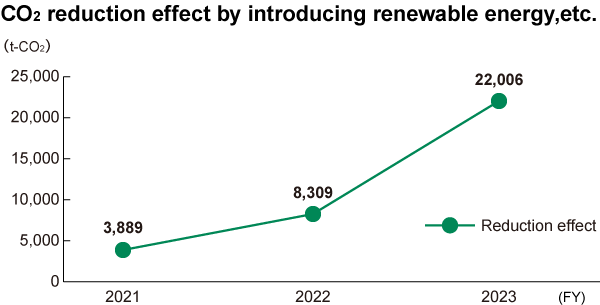
Interim targets for FY2025
| Items | Interim targets |
|---|---|
| Scope 1+2 |
From the FY2013 level: (70)% |
| Scope1 | From the FY2013 level: (40)% |
| Scope2 | From the FY2013 level: (80)% |
- *11The difference between the amount of emissions calculated using the basic emission factor and the amount of emissions calculated using the adjusted emission factor based on Japan's Act on Rationalization of Energy Use and Shift to Non-fossil Energy (Energy Saving Act) and Act on Promotion of Global Warming Countermeasures (Global Warming Countermeasures Act).
Targets for the Empowerment and Promotion of Women
-
Achieve the below presented ratios for the representation of women in various positions, an increase of 10% or more from the levels at the beginning of FY2021
(by the end of FY2030)
〈Ratio of female directors and executive officers at Resona Holdings: 30% or more〉
〈Ratio of female senior managers at five Group companies*12: 20% or more*13〉
〈Ratio of female line managers at five Group companies*12: 40% or more*13〉
| 2021*14 | 2024*14 | FY2030 targets | |
|---|---|---|---|
| Ratio of female directors and executive officers (Resona Holdings) |
19.2% |
10.3%*15 |
30% or more |
| Ratio of female senior manager*13 (5 Group companies*12) |
10.5% |
14.8% |
20% or more |
| Ratio of female line managers*13 (5 Group companies*12) |
29.7% |
32.8% |
40% or more |
- *12Sum of Resona Holdings, Resona Bank, Saitama Resona Bank, Kansai Mirai Financial Group, Kansai Mirai Bank and Minato Bank. Figures for FY2023 and earlier include Kansai Mirai Financial Group.
- *13As of April 1, 2024
- *14The ratio of female directors and executive officers is as of June 30 in 2021 and April 1 in 2024; the ratios of female senior managers and line managers are as of April 1 in 2021 and March 31 in 2024.
- *15Due to the increase in the overall number of executive officers and the internal appointment of female officers to serve as directors at Resona Bank and Saitama Resona Bank.
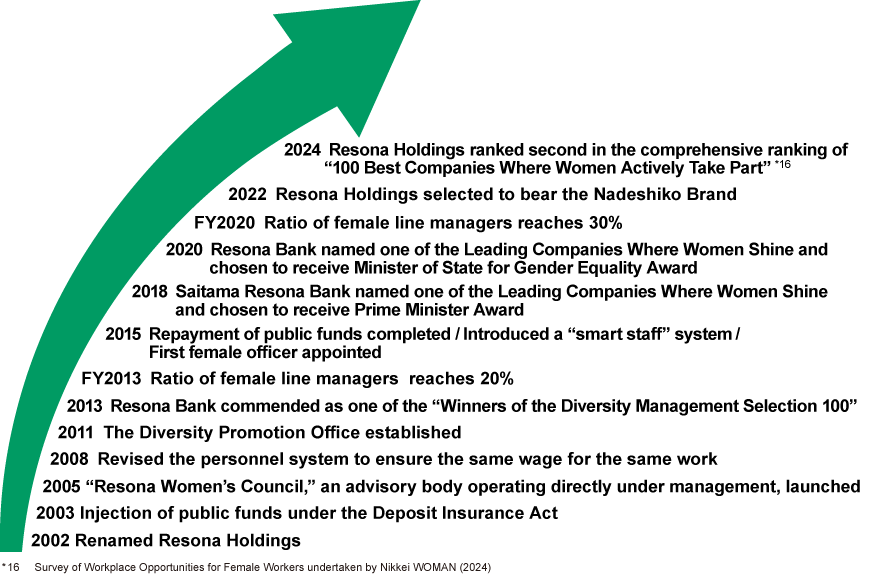
External Recognitions
